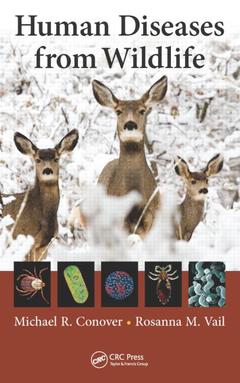Description
Human Diseases from Wildlife
Authors: Conover Michael R., Vail Rosanna M.
Language: English
Subjects for Human Diseases from Wildlife:
Keywords
Can; Reduce; Bacterial Diseases; Reservoir Hosts; Spirochetal Diseases; USFWS; Rickettsial Diseases; Feral Hogs; Viral Diseases; CDC 2013a; Zoonotic diseases; White Tailed Deer; E; Coli; Domestic Cats; Giardiasis; Lone Star Ticks; Transmission of pathogens to humans; CDC 2011b; Transmission vectors; Pe Rc; Wildlife diseases; Rocky Mountain Wood Tick; Tick Bite; Wildlife Damage Management; Denitive Hosts; Fungal diseases; Human Body Lice; Prions; Blacklegged Tick; Parasites; White Footed Mouse; Lyme disease; Western Blacklegged Tick; Influenza; Vee Virus; Anthrax; Prairie Dog; Tuberculosis; Tick Borne Relapsing Fever; Iowa State University; Spotted Fever
208.65 €
In Print (Delivery period: 15 days).
Add to cartSupport: Print on demand
Description
/li>Contents
/li>Readership
/li>Biography
/li>
Human Diseases from Wildlife presents information on the most prevalent and serious zoonotic diseases in the US and Canada, some of which have been national headline news like anthrax, influenza, and West Nile virus. Diseases that are caused by pathogens with the ability to infect both humans and animals are known as zoonotic diseases, which literally means "disease from animals."
The issue of human?wildlife disease interactions is a growing concern as humans continue to interface with wildlife. People who handle wildlife including field workers, wildlife professionals, trappers, and hunters want to know about potential diseases, risks, and how to protect themselves from disease.
This book was written because many people are uninformed about zoonotic diseases. This lack of information causes some people to have a heightened fear of zoonotic diseases, preventing them from enjoying wildlife or spending time outdoors. Other people needlessly expose themselves to disease by neglecting simple precautions.
This book includes information on bacterial, spirochetal, rickettsial, and viral diseases as well as macroparasites and emerging zoonotic diseases. More than two dozen diseases are covered including rabies, tularemia, baylisascariasis, salmonellosis, leprosy, Lyme disease, Rocky Mountain spotted fever, and swimmer?s itch.
Each chapter contains the history of the disease, symptoms in humans, medical treatment, transmission of pathogens to humans, the role of wildlife as vectors, and methods to minimize risk. The diseases people can contract from wild animals can be both threatening and fascinating, and the book includes interesting information to make it more enjoyable to read.
Bacterial Diseases. Spirochetal Diseases. Rickettsial Diseases. Viral Diseases. Fungal Diseases. Prions. Parasites.
Michael Conover is a professor in the Department of Wildland Resources at Utah State University. He received both an MS and PhD in zoology from Washington State University. He was a National Needs Postdoctoral Fellow in the Ecology and Evolutionary Biology Department at the University of California, Irvine, a position supported by the National Science Foundation. He is the editor of the journal Human-Wildlife Interactions and founding director of the Berryman Institute.




